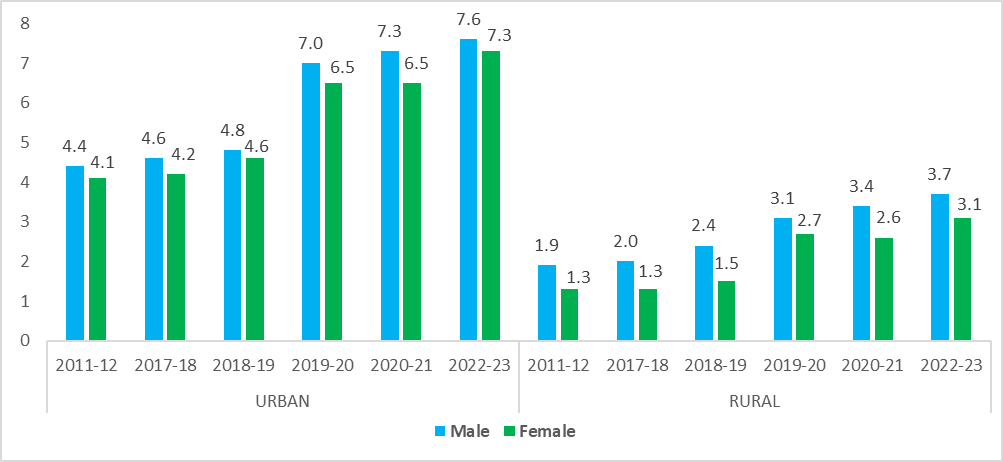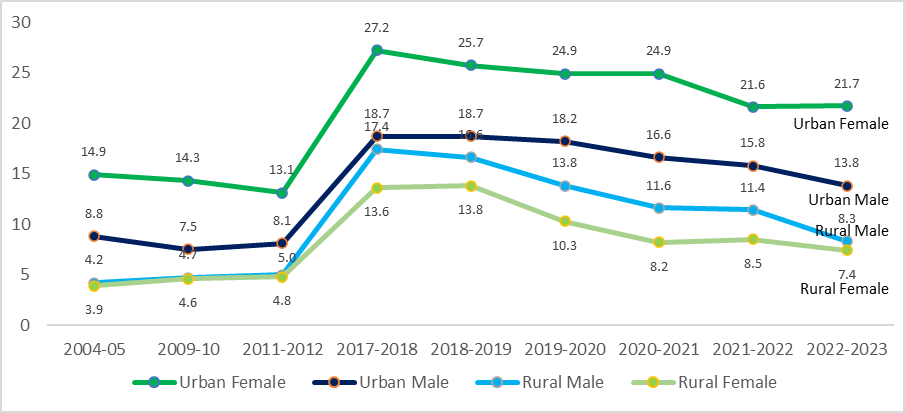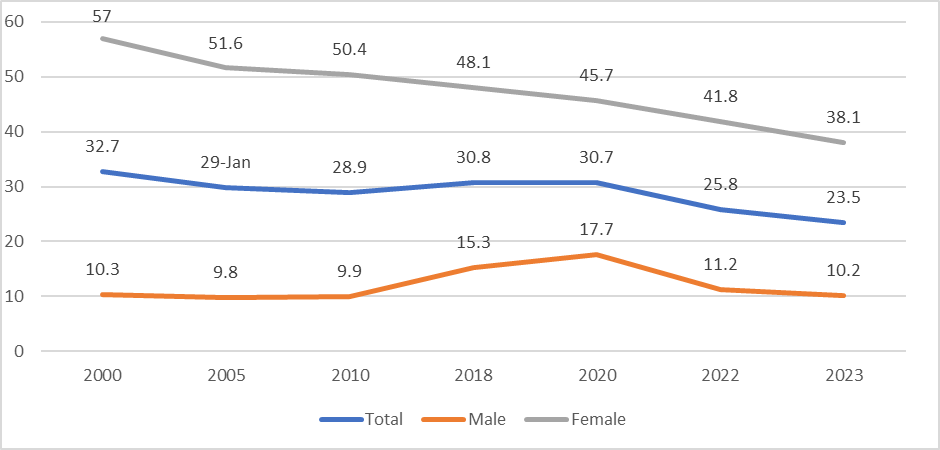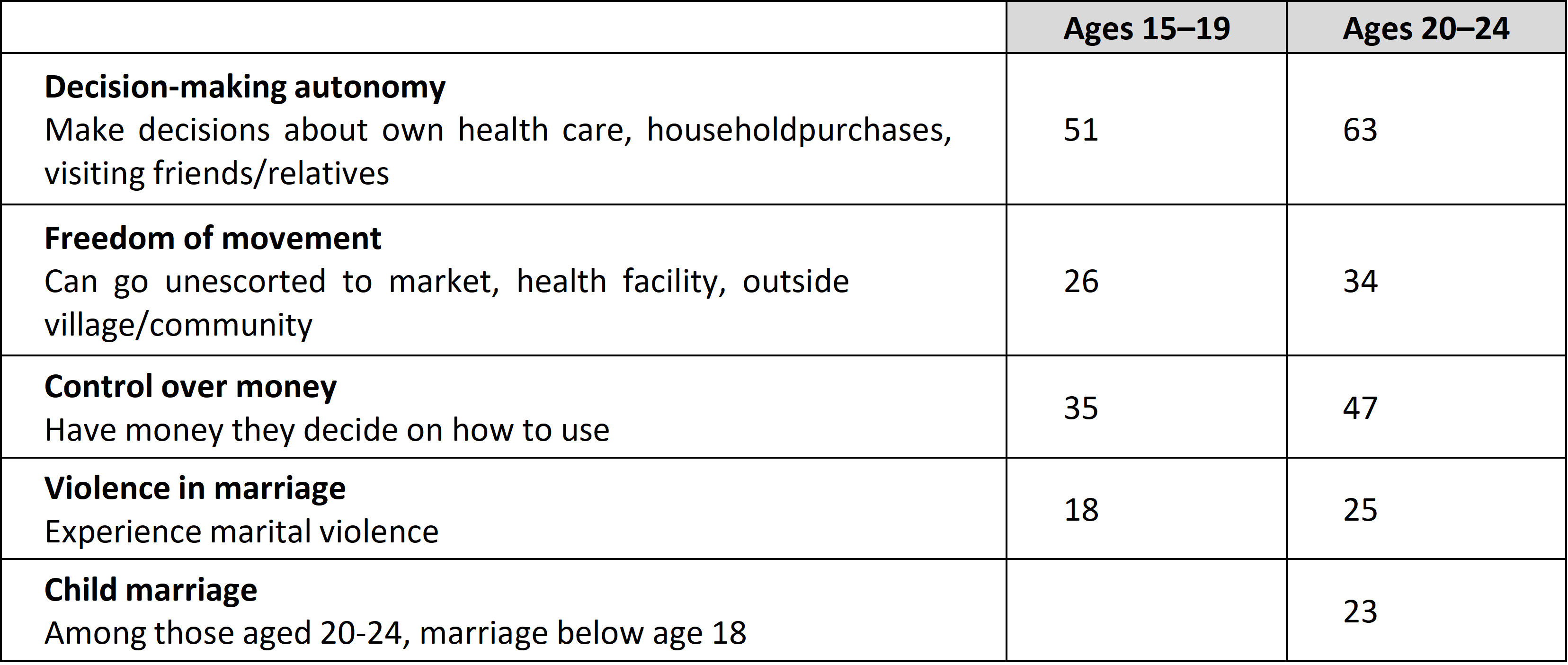India’s population is estimated to have reached 1.45 billion in 2024 to become the world’s largest. Over the course of the past century, the country has witnessed remarkable changes in its demographic scenario and has passed through a classical demographic transition (United Nations 2024). The total fertility rate was 2.0 in 2019–21 (compared with 2.7 in 2005–06 and 2.9 in 1998–99) and had reached replacement level in all but four states – Bihar, Jharkhand, Meghalaya, and Uttar Pradesh (IIPS and ICF 2021).
An important consequence of the steep decline in fertility that India has witnessed is the change in the age structure. Birth cohorts from earlier high fertility decades contribute to a youth bulge. With a working age population exceeding that of the dependent population (children and the elderly), the country is in an advantageous position of having a low dependency ratio and with the potential of being able to reap the demographic dividend (Kulkarni 2014, 2021).
This demographic dividend is, however, short lived. By 2061, the window of opportunity will close as the share of the elderly population grows, as it has in many of our neighbouring countries.
Much depends on whether and how India ensures an educated, skilled and healthy population of young people, with girls and young women participating equally.
Whether and how the demographic dividend is reaped depends hugely not only the size of the population, but also the skills and productivity of its labour force, which, in turn, are largely shaped by the situation of young people. To claim the advantage of the demographic dividend, two conditions must be met: the additional labour force resulting from the youth bulge must be productively employed, and the bulge population in the labour force must be appropriately educated, skilled and employable, and able to exercise their rights.
In short, much depends on whether and how India ensures an educated, skilled and healthy population of young people, with girls and young women participating equally with boys and young men, and with young people empowered to claim their rights. In all of these respects, young people are at a disadvantage, and India stands to squander its demographic dividend.
Education
Age-specific data show that gender disparities persist in educational attainment levels. Amongst youth aged 20–24, just 47% of young women and 53% of young men had completed higher secondary education or a college education by 2019–21, displaying markedly higher levels than in 2015–16 (38% and 47%) and 2005–06 (19% and 27%). Other socio-demographic inequities have also been observed, although narrowing over time. Rural youth (especially females), those from socially excluded groups, and those from eastern and central states are far less likely to have attained a secondary school education than others (IIPS and Macro International 2007, IIPS and ICF 2017, IIPS and ICF 2021).
Few youth in India enter into tertiary education. The All India Survey of Higher Education (AISHE 2021–22) observes that by 2021–22, the estimated Gross Enrolment Ratio (GER) in higher education (ages 18–23) was just 28.4 (28.3 amongst males and 28.5 amongst females). Across states, the GER ranged from 62–65% in Chandigarh and Puducherry, 40–50% in six others (Delhi, Himachal Pradesh, Kerala, Tamil Nadu, Telangana, and Uttarakhand) and just 17–20% in five others (Assam, Bihar, Chhattisgarh, Jharkhand, and Nagaland). In all, an estimated 4.3 crore young people aged 18–23 were enrolled in higher education institutions, of whom, nearly half (48%) were females. Inequities were wide. Just 5% of those enrolled were Muslims, 38% came from amongst OBCs, 15% from the SC community and 6% from the ST community. Subject-wise too, there was disparity. Overall, for example, fewer than one in four (23%) were enrolled in STEM, of whom 57% were male and 43% female (AISHE 2012–22).
A higher number of years of education attained does not guarantee good learning outcomes or future employability. The Annual Status of Education Report (ASER) 2023, conducted over 28 districts of 26 states, sheds light on poor learning outcomes (ASER Centre, 2024). Basic reading and arithmetic skills are not universal even amongst those who have completed secondary education, even of those in higher secondary (Classes 11–12) or tertiary (undergraduate or higher) education. For example, the ability to read a Class 2 text was reported by just 87.7% of those studying in Classes 11–12 and 92.4% of those in tertiary education, and to solve a long division problem was, correspondingly, 51.9% and 57.8%. Girls fared slightly better than boys in reading, and slightly worse than boys in numeracy skills. However, overall, girls fared far worse in conducting more complicated tasks. Just 72% and 78.2% of those in higher secondary and tertiary education could read and understand written instructions, even fewer could apply a discount (44.0% and 47.8%, respectively), including those in STEM or commerce streams (50-54%).
Digital literacy, moreover, is limited. The ASER report shows for example that amongst adolescents aged 14–18 in rural areas, although almost all have a smart phone at home (87–91%), and can use one (90–94%), far more boys than girls own a smartphone (44% vs. 20%). In contrast, very few (8–9%) have a computer at home, and few know how to use one (90% boys, 80% girls who have a computer at home; 40% and 29%, respectively, of those who do not). Not all have email ids (51% of males, 30% of females), and even fewer (20% of males, 9% of females) have ever sent an email. Of those who were familiar with smart phone use, moreover, far more reported social media use for entertainment (82% of males, 74% females) than for education (65-68%) or accessing services (19-38%) (ASER Centre, 2024).
With regard to technical and vocational education and training (TVET), despite the attention given to skilling India, few young people have undergone formal skill building education (Figure 1). Over successive surveys conducted in the decade from 2011–12 to 2022–23, fewer than 10% of young adults had acquired such training, most recently (2023) just 4.4% of the population aged 15–29 (4.6% of males and 4.2% females). As evident from Figure 1, training was undertaken by more young men than young women and more urban than rural youth (MOSPI, 2023).
Figure 1: Percentage of persons of age 15–29 years who received formal vocational/technical training (2011-12 – 2022-23)

Labour force participation
That there are limited job market opportunities available to young people is obvious and widely discussed (MOSPI 2019, 2021, 2023, Mehrotra and Parida 2019). Between 2004–05 and 2022–23, labour force participation rates actually declined sharply up to 2018–19 for both the total population (15+) and youth aged 15–29, and increased thereafter (Figure 2).
Labour force participation differs hugely by age and sex in India in each year. Compared to the overall working age population (ages 15+), labour force participation rates of youth are significantly lower (45% versus 57.9% in 2022-23), and even amongst youth, young women are far less likely than young men to be in the labour force (24.5% versus 63.5%). For young men, there was a virtual stagnation in labour force participation between 2017–18 (59%) and 2020–21 (60%) followed by an approximately three percentage point increase (63%) in 2022–23. For young women, rates stagnated in the period 2017–19 (16%) followed by an increase to 24.5% by 2022–23. Notably, despite this increase, rates for the young have not yet reached levels observed in the period 2005–2012.
Figure 2: Labour force participation rates (in percent; youth, all working ages; 2004-05 – 2022-23)

There are several factors accounting for the trends in labour force participation, especially for young women. Of course, the numbers of youth remaining in education longer has increased markedly, keeping them out of the labour force. But at the same time, for women and girls, there exist limited culturally-acceptable, woman-friendly job market and wage employment opportunities compared to elsewhere, such as, for example, the opportunities provided by the garment industry in Bangladesh, and in some instances in India, call centre opportunities (Fletcher at al. 2017). At the same time, the diminishing of farming jobs has further exacerbated this predicament (Chatterjee at al. 2015). In addition, occupational gender segregation persists (Paul and Raju 2014), and wages for females are often well below those for male workers at the same level of education in each industry (Naidu 2016).
For women and girls, there exist limited culturally-acceptable, woman-friendly job market and wage employment opportunities.
On the demand side, patriarchal norms inhibit women and girls from accessing occupations that may involve contact with men (see, for example, Jejeebhoy and Kumar 2021). Childrearing and domestic responsibilities inhibit many women from engaging in full-time or non-agricultural employment. Many in India prefer the flexibility offered at home or on the farm, or casual jobs than a regular, full time job. For example, the NSS has observed that 72% of women who were willing to accept work if made available favoured regular, part-time jobs over regular, full-time jobs (Chatterjee at al. 2015, MOSPI 2014).
Trend data show that unemployment rates amongst youth (ages 15–29) were steady in the period 2004–05 to 2011–12, then experienced a marked increase to 2017–18 to 2019–20, and a modest decline thereafter. Unemployment was far higher amongst the young than the population at large.For example, in 2022–23, it was 3% amongst the total population aged 15+, but 10% amongst youth aged 15-29 (MOSPI 2022). Youth unemployment was particularly marked in urban areas. While 8.3% of rural young men and 7.4% of rural young women were unemployed in 2022–23, percentages were as high as 14 and 22, respectively in urban areas (see Figure 3).
Unemployment rates were particularly high amongst the educated, raising questions about the mismatch between available skills on the one side and employment opportunities on the other (ILO 2022). A recent report concludes that while Indian youths are attaining high levels of education, not enough employment opportunities are getting created for them. Moreover, in segments in which there is potential for youth to gain employment, such as those where modern rather than traditional skills are in demand, issues related to low skills and employability persist and reduce their advantage in these segments (ILO and Institute for Human Development, 2024).
Figure 3: Unemployment rates according to usual status (ps+ss) for youth (in percent, 2004-05--2022-23)

Not in Education, Employment, or Training
SDG Target 8.6 calls for a substantial reduction in the percentage of youth (18–24) not in employment, education, or training (NEET) 1NEET rates are calculated as shares of the entire youth cohort who are not in employment (labour force), and also not in education and training: NEET rate (%) = (Youth – (Youth in employment – Youth not in employment but in education or training) / Youth *100. (United Nations, 2020). This is a powerful measure of the vulnerability of youth, and reflects a country’s ability to reap the demographic dividend.
India has amongst the highest NEET rates in the world and the biggest gap between young men and young women, according to a comparative analysis of NEET in 11 countries reflecting general global trends (ILO/Sida Partnership on Employment, nd). 2Azerbaijan, Chile, Costa Rica, Egypt, Ethiopia, India, Peru, Philippines, Portugal, Rwanda, Saudi Arabia Figure 4 shows that the NEET rate in India for the cohort aged 15–24 was 33% in 2000, and fell to 24% in 2023 (Figure 4).
Gender disparities have been wide. It is young women’s higher NEET rates that dominate the overall NEET rate for the youth cohort. For young men, the NEET rate was 8–10% for the period 2000–2011, increased to 18% during 2020, then declined to 10% by 2023. For young women in contrast, NEET rates record a consistent, albeit mild, decline from 57% in 2000, but even so, as of 2023, as many as 38% fell into this category (ILOSTAT explorer, ILO, nd(b)).
Figure 4: Indian youth (15-24 years) not in employment, education and training (in percent, 2000-2023)

Patriarchal social norms and gender gaps
The wide gender disparities in rates of NEET, in compromised learning outcomes, and in lower rates of labour force participation and workforce opportunities experienced by young women and girls compared to young men and boys stand testimony to the fact that India is one of the most gender unequal countries in the world.
Girls and young women are especially disadvantaged. The persistence of patriarchal social norms inhibits their exercise of choice, and the lack of acceptable opportunities and entitlements that recognise the constraints that girls and young women face translates into denial of opportunities to seek higher education, vocational training or a career. Indeed, the Global Gender Gap Report (World Economic Forum 2024) ranks India 129th amongst 146 countries and lists it as the third worst performer of seven nations of South Asia. 3The Global Gender Gap Report benchmarks across countries the evolution of gender-based gaps in economic participation and opportunity and educational attainment, health and survival, and political empowerment.
That girls are poorly valued is evident from the far greater investment by parents in the education of sons than daughters (private school, after-school coaching, etc.) (ASER 2022), and priorities that emphasise household responsibilities over education for girls. Girls and women in India bear the brunt of domestic work. For example, 74% of women ages 15 and above across rural India whose homes lack a source of water, undertake time-consuming efforts to collect drinking water for the household, as compared with just 21% of men (IIPS and ICF 2021).
Gender inequitable household roles further compound low labour force participation rates among women. Hence, leading factors for NEET expressed by young women were their need to fulfil family responsibilities, followed by a lack of suitable work opportunities. In contrast, for young men, the leading factor was unemployment and limited availability of suitable work (ILO/Sida Partnership on Employment, nd).
Family honour and the link of girls’ ‘sexual purity’ with family honour means that girls are closely guarded and denied entry into spheres outside the home that are available to men and boys. They are restricted in terms of the kinds of education and work opportunities they may pursue.
A qualitative study exploring girls’ career aspirations in rural Rajasthan reiterates the ways in which social norms have compromised girls’ lives (Jejeebhoy and Kumar 2021). Girls are socialised with narrow aspirations for their futures aside from marriage; those reporting career aspirations cite careers that will be acceptable in the marital home, and can be combined with domestic responsibilities (teacher, frontline health worker, seamstress, beautician), although exceptions do exist (doctor, police, army). Parents deeply fear possible loss of family izzat if their daughter becomes ‘tainted’ – engage in relations with a boy, or experience sexual assault – in the eyes of elders. Higher education, skilling opportunities, use of public transport, or career choices involving mixing with boys and men are perceived as a risk and are therefore discouraged:
Some people say that the girl goes out and no one knows where she goes. She should not be allowed to go alone. She will spoil the honour of her parents. [A rural girl aged 18 who completed Class 10 and not in school, work or training,]. If she goes away [college/work] and some accident or gadbad [bad incident] … then what? If a girl goes off with someone and gets married, our society will keep passing comments… if a girl runs off with a boy (galat kaam), she won’t be allowed back home. [A rural mother aged 40 with no formal education, and a daughter in Class 12].
Child and early marriage compounds the limited options of girls; almost one quarter of young women aged 20–24 are married before age 18, and few have a say in whom and when they marry. Within marriage, decision-making power on issues relating to themselves is far from universal, freedom to move around without an escort is limited, and control over money is exercised by fewer than one half. Marital violence is widespread, experienced by one in six adolescents and one in four young women aged 20–24. Together, these constraints effectively dent their chances of realising education and work aspirations and joining the modern employment sector (Table 5).
Table 5: Decision-making, freedom of movement, control over money, experience of marital violence and child marriage: Factors inhibiting girls and young women from exercising rights, 2019–21

Reaping the demographic dividend
This review has highlighted several challenges that, if current trends continue, will inhibit India from reaping the benefits of its favourable age structure. These have included, for example, poor learning outcomes, limited skills for employment generated, the gap between young people’s qualifications and market opportunities, and the continued exclusion of girls and women from the development process. Aside from the obvious need to boost public expenditure on the social sector and make the employment environment more responsive to youth needs and disadvantages, there are a number of promising and evidence-based leads for investment that focus on educating, empowering young people and ensuring their rights and employability.
In the schooling arena, promising strategies to improve attendance and secondary school completion as well as learning outcomes include the provision of conditional and unconditional cash and non-cash transfer (scholarships and vouchers, bicycles for secondary school) programmes. Indirect benefits are also observed, most notably, delaying marriage (Malhotra and Elnakib 2021, Glewwe and Muralidharan 2015, Muralidharan and Prakash 2019, Petrosino et al. 2012, Gundi et al. 2021). Supplementary coaching for disadvantaged students/first time learners is essential to address their disadvantage, and has been shown to enhance learning outcomes and encourage school continuation (Glewwe and Muralidharan 2015, Banerjee et al. 2007).
Also important is gender transformative life skills education for the young at school and community levels that promote gender egalitarian norms and facilitate exercise of rights. These programmes build gender equity among both boys and girls, raise awareness about health and rights, impart communication and negotiation skills to make informed decisions, foster critical thinking and a sense of self efficacy, and convey a sense of informed future orientation (Malhotra and Elnakib 2021, UNFPA 2016, Patton et al. 2016, Santhya et al. 2021).
Among efforts to enhance female labour force participation, most promising are interventions offering skilling and career opportunities (Malhotra and Elnakib 2021) that go beyond simply provide skilling or vocational training institutions. What is needed is a range of related services: generation of new 21st century skills and opportunities, career counselling, soft skills training, job search support, job-related mentoring as necessary, safe transport to access places of work, safe work place environment and overcoming attitudinal obstacles posed by gatekeepers (Malhotra and Elnakib 2021, Jensen 2012).
Other less evidence-based are also important. First, given persisting child marriage, programmes must encourage married young women into the labour force, with appropriate attention to the provision of childcare benefits and availability of part-time work. Second, parents and other gatekeepers, key in imposing traditional norms, must be reached in efforts to impart positive and 21st century socialisation practices, and break down traditional biases against investing in women and girls. Third, as a result of age structure changes, large waves of labour migration of youth from high fertility to low fertility states is already happening. Efforts must be available that enable young migrants to assimilate in their new work environment, supporting them to adapt to cultural and language barriers in destination states, and generally claim the various rights and entitlements accessed by the native population.
Finally, systems must adapt. Manufacturing and service sectors must be open to on-the-job training and internship opportunities, adopt measures that enable young women to balance work and childcare, and attend to women’s physical safety in the workplace. Better quality education is imperative to ensure basic learning outcomes and future employability, health systems must ensure universal health coverage and minimise out-of-pocket expenditure, and capacity building of teachers, trainers, and health care providers is imperative that not only conveys domain skills but also clarify values and break down gendered social norms that even inadvertently discriminate against young women and girls.
It is evident that India has recognised the risk it faces of squandering its demographic dividend. The Union Budget for 2024, for example, has indeed proposed impressive schemes in theory; questions remain about how these new schemes to boost skilling, generate employment and enhance labour force participation of women and girls will be implemented in practice.
Shireen Jejeebhoy is a social scientist and demographer. She is the director of Aksha Centre for Equity and Wellbeing, a visiting distinguished faculty at International Institute for Population Sciences, and president of International Union for the Scientific Study of Population, Paris. Sanjay Kumar is a population dynamics and research specialist at United Nations Population Fund (UNFPA) - India.
This article draws on and updates an earlier article by authors published in Demography India. We are grateful to the editors for permission to use this material. Views expressed in this article are those of the authors and do not reflect those of the organisations with which they are affiliated.









